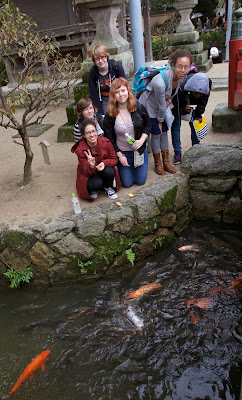Today we took a tram, shinkansen, express train, and private rail to get to the old city of Dazaifu. It was the administrative center of the western island of Kyushu from the 7th century. Highlights from the day included the Kyushu National Museum, built just about 10 years ago where we learned about Japan and its neighbors through cultural artifacts. Be on the look out for blog posts from Trippers that describe what objects they had an affinity towards. Our time in the museum was cut short by our growing hunger where we explored the main street lined with shops and street food. We then visited the original Tenmangu Shrine (early 10th century) for sights and sounds of "shichi-go-san matsuri," or 7-5-3 festival, where children dress up in traditional kimono and visit a shrine to pray for girls who have turned 3 and 7 and boys who have turned 5 in the past year. We then visited Komyozen-ji Zen temple for quiet reflection, solice, and a gorgeous Zen-style rock garden. Exquisite. We ate a lovely curry rice meal at the local "mom and pop" shop in a town called Futsukaichi before retracing our steps, taking 4 forms of tranport before baths and blogging.


Dreary weather, but only a little rain . . .
Washing hands in a purification ritual before entering the shrine.
Ancient trees growing around Tenmangu Shrine
A typical chrysanthemum display often found at temples and shrines in November
Dressed for the 7-5-3 Festival
"Ema" are boards that you write wishes on and place in special places within a shrine or temple. Tenmangu Shrine is well known for best wishes on exams.
The rain neither dampened our mood or our experiences. It added a dimension to our visit.
Komyozen-ji temple. A favorite spot for journaling, drawing, and of course photographing.
Post "Killer Curry," (name of the shop in translation), where the meal was universally enjoyed.


























